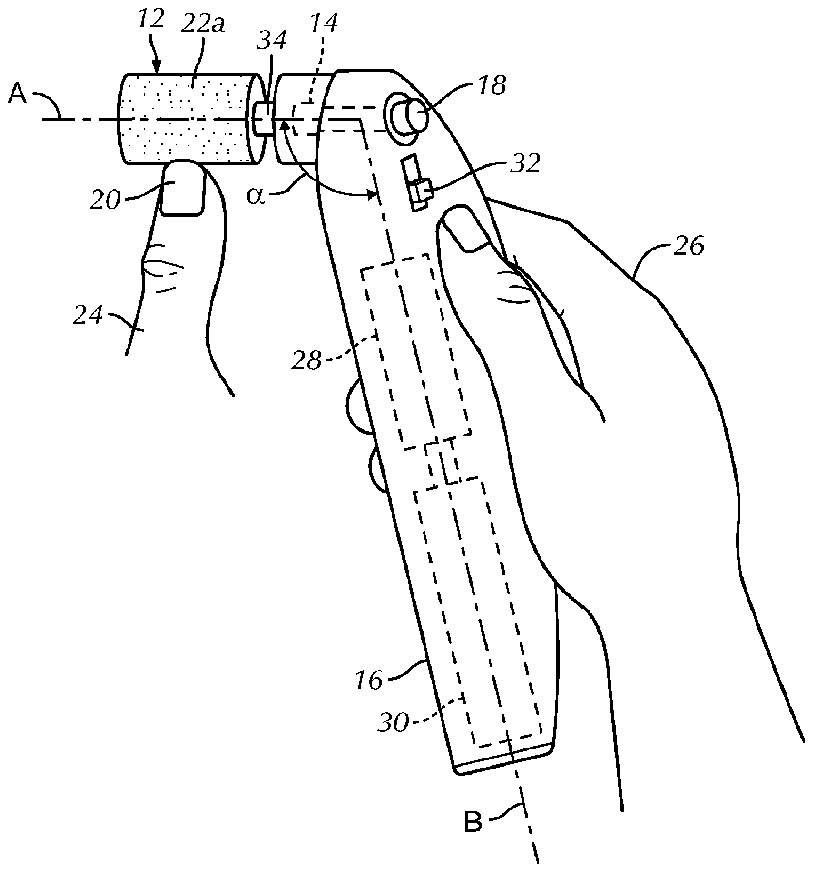
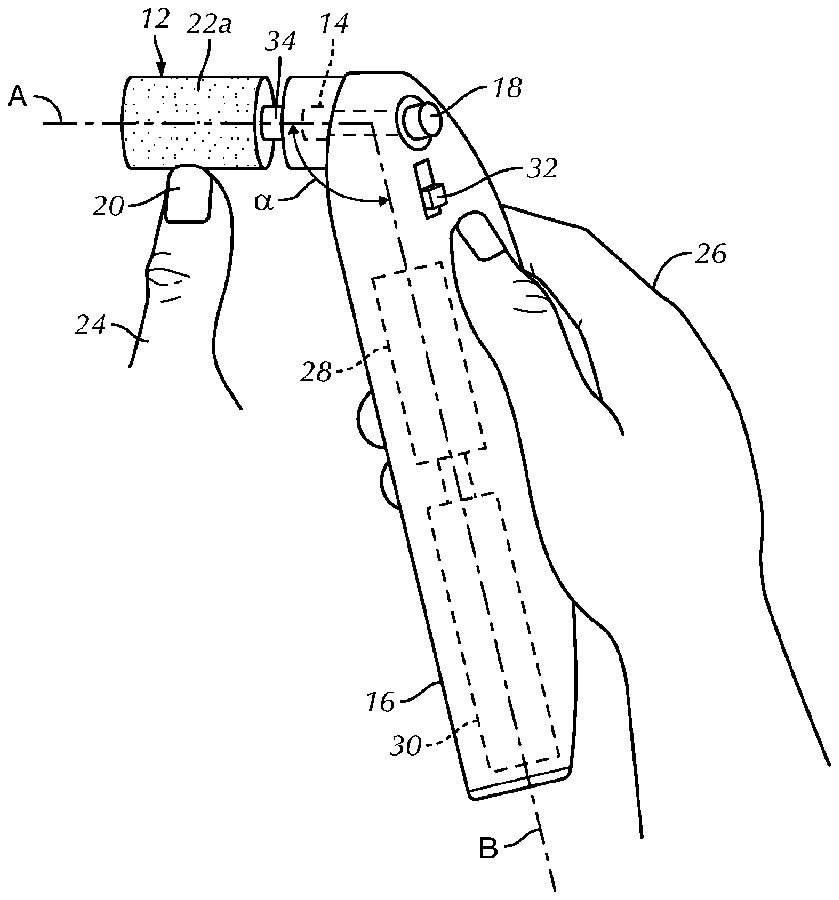
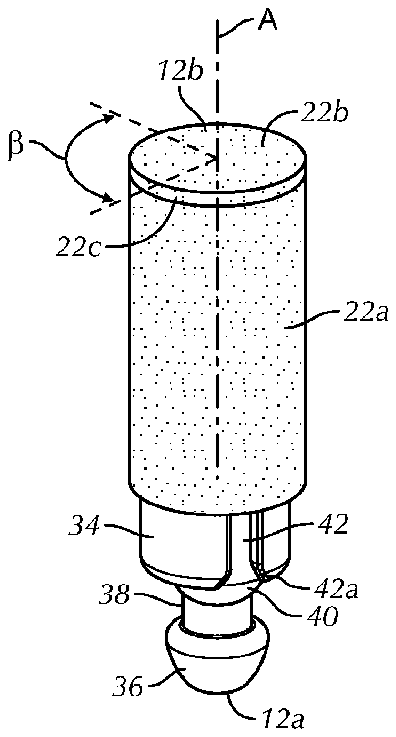
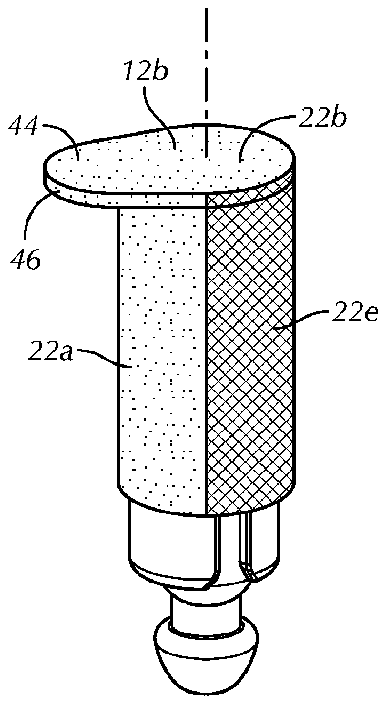
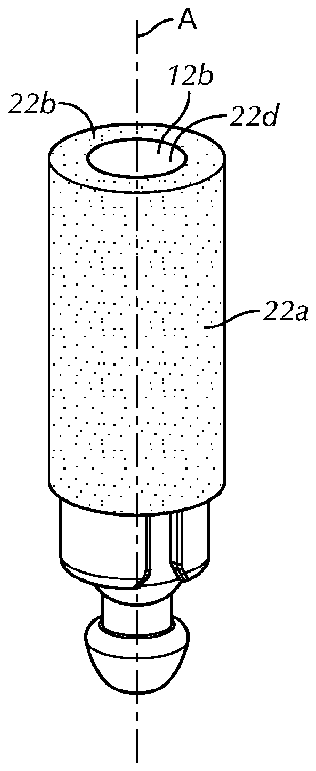
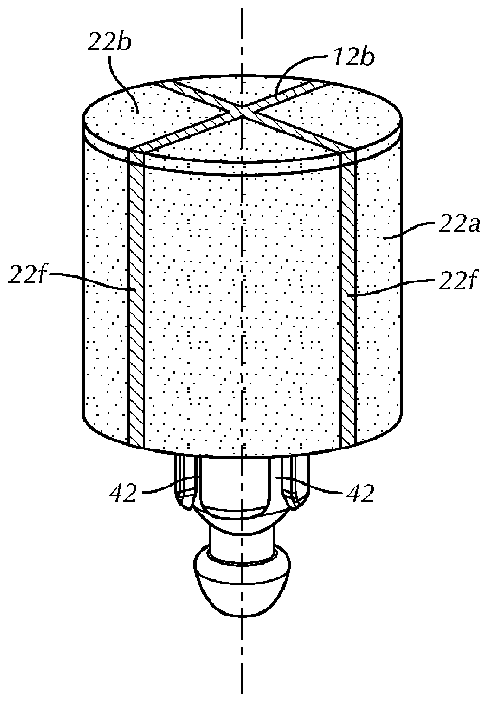
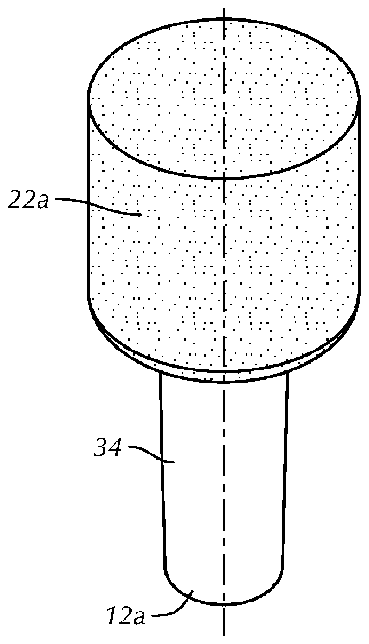
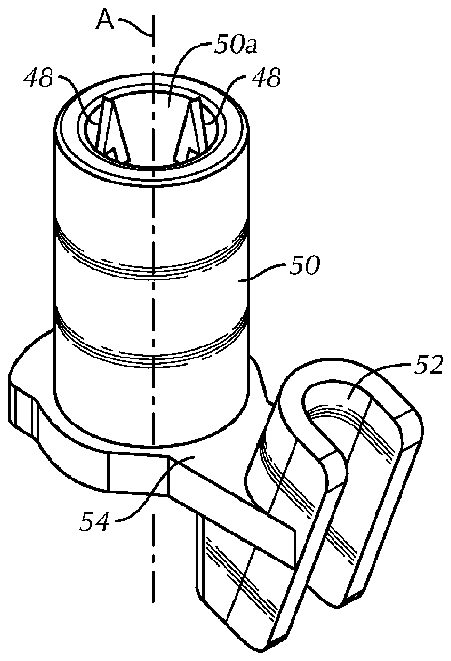
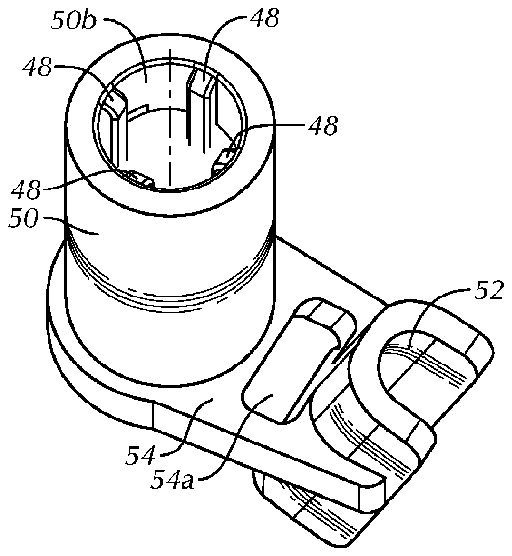
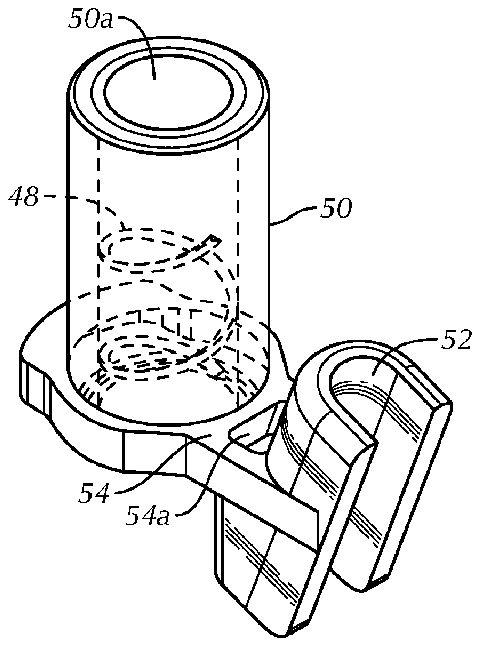
- 10nail file
- 12nail file head
- 14boss
- 15approximately
- 16housing
- 18release button
- 20nail
- 22abrasive surface
- 24hand
- 26hand
- 28motor
- 30battery
- 32switch
- 34stem
- 36tip
- 42radially extending features
- 44cutting tool
- 46cutting surface
- 48radially extending features
- 50sleeve
- 51t operating position being approximately
- 52shoe
- 54extension
- 60approximately
- 72first operating position being
- 90first operating position being
- 120first operating position being
- 180first operating position being
- 400approximately
Abstract
An apparatus comprises a housing having a shape and size suitable for being held in a single hand of a user. A nail file head is coupled to the housing. An electric drive device is contained within the housing and configured to rotationally oscillate the nail file head about an axis. An abrasive surface is coupled to the nail file head configured to trim or smooth a fingernail or toenail when the nail file head is oscillated. The abrasive surface extends around and faces radially away from the axis.
Description
CROSS-REFERENCE TO RELATED APPLICATIONS
[0001] This application claims the benefit of U.S. Provisional Patent Application No. 61/672,079 filed Jul. 16, 2012 entitled “Motorized Nail File”, incorporated by reference herein in its entirety.
BACKGROUND OF THE INVENTION
[0002] The present invention generally relates to motorized nail files.
BRIEF SUMMARY OF THE INVENTION
[0003] In one embodiment there is an apparatus comprising: a housing having a shape and size suitable for being held in a single hand of a user; a nail file head coupled to the housing; an electric drive device contained within the housing and configured to rotationally oscillate the nail file head about an axis; and an abrasive surface coupled to the nail file head and configured to trim or smooth a fingernail or toenail when the nail file head is oscillated, the abrasive surface extending around and facing radially away from the axis.
[0004] In one embodiment, the abrasive surface is a first abrasive surface, the apparatus further comprising: a second abrasive surface, the second abrasive surface being generally perpendicular to the first abrasive surface. In one embodiment, the second abrasive surface is circular. In one embodiment, the first abrasive surface has a different grit than the second abrasive surface. In one embodiment, the first and second abrasive surfaces are comprised of sandpaper. In one embodiment, a distal portion of the nail file head extends radially from the axis further than the abrasive surface extends from the axis. In one embodiment, the distal radial portion of the nail file head includes a cutting surface. In one embodiment, the abrasive surface is cylindrically shaped.
[0005] In another embodiment there is an apparatus comprising: a nail file head configured to rotationally oscillate about an axis; an abrasive surface coupled to the nail file head and configured to trim or smooth a fingernail or toenail when the nail file head is oscillated; and a stem extending from the nail file head and configured to releasably couple the nail file head to a housing, the stem including one or more radially extending features configured to mate with one or more corresponding radially extending features of the housing.
[0006] In one embodiment, the one or more radially extending features includes one or more axially extending grooves. In one embodiment, the stem is configured to couple with the housing in two or more different, predetermined, radial positions. In one embodiment, the stem is configured to couple with the housing in four or more different, predetermined, radial positions. In one embodiment, the stem is coupled to a clutch that is configured to allow a user to twist the nail file head between two or more different, predetermined, radial positions relative to the housing. In one embodiment, the stem is configured to snap fit into the housing. In one embodiment, the stem is configured to snap fit into the housing upon an initial coupling between the stem and the housing and not snap fit into the housing upon subsequent coupling between the stem and the housing. In one embodiment, a proximal end of the stem includes a bulbous tip. In one embodiment, the abrasive surface is cylindrically shaped. In one embodiment, the abrasive surface includes a cylindrically shaped sidewall portion and a planar, circular, distal end portion.
[0007] In another embodiment there is an apparatus comprising: a nail file head configured to rotationally oscillate about an axis; a first abrasive surface coupled to the nail file head and configured to trim or smooth a fingernail or toenail when the nail file head is oscillated; a second abrasive surface coupled to the nail file head and configured to trim or smooth a fingernail or toenail when the nail file head is oscillated; and a stem extending from the nail file head and configured to releasably couple the nail file head to a housing, the stem including two or more axially extending grooves and a bulbous proximal tip, the two or more axially extending grooves configured to mate with one or more corresponding axially extending projections of the housing, the bulbous proximal tip configured to snap fit into the housing upon coupling the nail file head with the housing.
[0008] In another embodiment there is a method of filing or trimming a fingernail or toenail comprising: oscillating a nail file head about an axis, a distal end and a proximal end, the proximal end of the nail file head configured to be coupled to a housing, the nail file head having a first abrasive surface coupled to a distal end of the nail file head and perpendicular to the axis and a second abrasive surface coupled to the nail file head, the second abrasive surface extending around and facing radially away from the axis; and contacting one of the first or second abrasive surfaces with the fingernail or toenail to trim or file the fingernail or toenail. In a further embodiment, the method includes rotating the nail file head at least 45 degrees relative to the housing; oscillating the nail file head about the axis; and contacting one of the first or second abrasive surfaces with the fingernail or toenail to trim or file the fingernail or toenail.
BRIEF DESCRIPTION OF THE SEVERAL VIEWS OF THE DRAWINGS
[0009] The foregoing summary, as well as the following detailed description of embodiments of the motorized nail files, will be better understood when read in conjunction with the appended drawings of exemplary embodiments. It should be understood, however, that the invention is not limited to the precise arrangements and instrumentalities shown.
[0010] In the drawings:
[0011] FIG. 1 is an perspective view of a motorized nail file during use in accordance with an exemplary embodiment of the present invention;
[0012] FIG. 2 is a perspective view of a nail file head removed from the motorized nail file shown in FIG. 1 ;
[0013] FIG. 3 is a perspective view of a nail file head in accordance with another exemplary embodiment of the present invention;
[0014] FIG. 4 is a perspective view of a nail file head in accordance with another exemplary embodiment of the present invention;
[0015] FIG. 5 is a perspective view of a nail file head in accordance with another exemplary embodiment of the present invention;
[0016] FIG. 6 is a perspective view of a nail file head in accordance with another exemplary embodiment of the present invention;
[0017] FIG. 7 is a perspective view of a boss of the motorized nail file shown in FIG. 1 ;
[0018] FIG. 8 is a perspective view of a boss in accordance with another exemplary embodiment of the present invention; and
[0019] FIG. 9 is a perspective view of a boss in accordance with another exemplary embodiment of the present invention.
DETAILED DESCRIPTION OF THE INVENTION
[0020] Motorized nail files are used to apply a moving abrasive surface to a finger or toe nail. Oscillating tools are able to accomplish this task while lessening the potential of physical damage (e.g., cuts, bleeding, bruising) to surrounding skin. Motorized nail files are particularly useful to trim nails of others including pets, children, the elderly, patrons at a salon and the infirm. A motorized nail file is disclosed in U.S. Pat. No. 7,188,628, which is hereby incorporated by reference in its entirety.
[0021] Referring to the drawings in detail, wherein like reference numerals indicate like elements throughout, there is shown in FIGS. 1-9 a motorized nail file, generally designated 10 , in accordance with exemplary embodiments of the present invention.
[0022] Referring to FIG. 1 , in one embodiment, nail file 10 includes a spindle such as a nail file head 12 configured to trim, smooth or file a person's or animal's fingernail or toenail 20 when nail file head 12 is oscillated about axis A. In one embodiment, nail file head 12 includes an abrasive surface 22 a such as sanding paper, an emery board, or other abrasive compound. In one embodiment, nail file head 12 is driven by an electric drive device 28 such as a motor. In one embodiment, motor 28 is powered by a battery 30 . In one embodiment, abrasive surface 22 a is oscillated or vibrated by a predetermined speed and a predetermined action, and includes a selected texture to remove portions of nail 20 while maintaining the surrounding epidermal tissue of a hand 24 substantially free from any physical damage.
[0023] In one embodiment, nail file 10 is a small handheld battery powered or corded device that safely trims people's nails by leveraging certain physical properties of the skin and nail tissue. In one embodiment, a trimming action is driven by a motor 28 of appropriate speed and torque and a mechanism that converts the rotation of the motor shaft to an oscillating action. In one embodiment, nail file head 12 oscillates with a frequency and stroke that optimizes the trimming of the nail while not adversely affecting surrounding skin. Because of the soft and supple nature of the skin, the oscillating action of nail file head 12 vibrates or shifts the skin back and forth while the more rigid nail 20 is filed or trimmed.
[0024] In one embodiment, nail file 10 includes a housing 16 . In one embodiment, housing 16 is shape and size suitable for being held in a single hand 26 of a user. In one embodiment, nail file head 12 is coupled to housing 16 via a boss 14 . In one embodiment, nail file head 12 is releasably coupled to housing 16 as described further below. In one embodiment, a release button 18 extends from housing 16 . In one embodiment, release button 18 is used to release nail file head 12 from boss 14 . In one embodiment, nail file 10 includes a power switch 32 . In one embodiment, power switch 32 turns motor 28 ON/OFF. In other embodiments, the speed of motor 28 is controlled by switch 32 or an additional control such as a speed control.
[0025] In one embodiment, nail file head 12 oscillates about axis A. In other embodiments, nail file head 12 oscillates side to side or about an arc. In one embodiment, nail file head 12 oscillates at a generally constant frequency. In one embodiment, nail file head 12 oscillates at approximately 15 hertz to approximately 20,000 hertz. In one embodiment, a rotary output from motor 28 is converted to the oscillation of nail file head 12 . In other embodiments, motor 28 is configured to oscillate. In one embodiment, axis A is generally orthogonal with a longitudinal axis B of housing 16 . In one embodiment, axis A is at an oblique angle α with respect to axis B. In one embodiment, angle a as shown is approximately 40 degrees. In one embodiment, angle a is fixed. In one embodiment, angle α is adjustable. In another embodiment, the axis of oscillation is perpendicular to axis A and axis B as shown in FIG. 1 .
[0026] Referring to FIG. 2 , in one embodiment, nail file head 12 oscillates about axis A a predetermined radial angle β. In one embodiment, predetermined radial angle β is approximately 45 degrees. In one embodiment, predetermined radial angle β is approximately 40 degrees to approximately 50 degrees.
[0027] In one embodiment, nail file head 12 includes any number and configuration of surfaces to file, trim and smooth nail 20 . In one embodiment, nail file head 12 includes at least one abrasive surface 22 a. In one embodiment, nail file head 12 includes two abrasive surfaces 22 a, 22 b. In one embodiment, nail file head 12 includes a buffing surface. In one embodiment, abrasive surface 22 b is planar. In one embodiment, the sidewall portion of nail file head 12 is cylindrical. In one embodiment, distal end 12 b of nail file head 12 is circular. In one embodiment, abrasive surface 22 b is circular. In one embodiment, distal end 12 b of nail file head 12 and/or abrasive surface 22 b is semi-spherical, conical or pointed. In one embodiment, abrasive surface 22 b is perpendicular to axis A. In one embodiment, abrasive surface 22 b is the distal most surface extending from nail file head 12 . In one embodiment, abrasive surface extends from axis A to an outer perimeter 22 c. In one embodiment, abrasive surface 22 b includes an aperture 22 d (see FIG. 4 ). In another embodiment, abrasive surface 22 b may include a distally extending projection to provide additional abrasive surfaces or edges. In one embodiment, abrasive surface 22 b extends to abrasive surface 22 a.
[0028] In one embodiment, abrasive surface 22 a extends around and faces radially away from axis A. In one embodiment, abrasive surface 22 a is cylindrically shaped. In other embodiments, abrasive surface 22 a is a non-cylindrical shape such as rectangular, hourglass or cone. In one embodiment abrasive surface 22 a is symmetrical about axis A. In one embodiment, a cylindrically shaped abrasive surface 22 a provides an abrasive surface along the axial length that moves at a single speed as opposed to abrasive surface 22 b that has a surface that moves at different speeds depending on the distance from axis A. In one embodiment, abrasive surface 22 a is generally perpendicular to abrasive surface 22 b.
[0029] In one embodiment, abrasive surface 22 a has a different grit than abrasive surface 22 b . In one embodiment, abrasive surfaces 22 a, 22 b are comprised of sandpaper. In one embodiment, abrasive surfaces 22 a, 22 b are comprised of stearate coated aluminum oxide paper. In one embodiment, abrasive surface 22 a is a different grit than abrasive surface 22 b. In one embodiment, abrasive surface 22 a has the same grit than abrasive surface 22 b. In one embodiment, abrasive surface 22 a is approximately 60 grit to approximately 400 grit. In one embodiment, abrasive surface 22 b is approximately 60 grit to approximately 400 grit. In one embodiment, abrasive surface 22 b is attached to abrasive surface 22 a. In one embodiment, abrasive surface 22 b is attached to abrasive surface 22 a by an adhesive. In another embodiment, abrasive surface 22 b is integral with abrasive surface 22 a.
[0030] In one embodiment, nail file head 12 includes a stem 34 . In one embodiment, stem 34 couples nail file head 12 to housing 16 . In one embodiment, stem 34n> releasably couples nail file head 12 to housing 16 . In one embodiment, once stem 34 is coupled with housing 16 , nail file head 12 is not released until button 18 (see FIG. 1 ) is actuated. In one embodiment, stem 34 is rigidly connected to nail file head 12 . In one embodiment, stem 34 is co-axial with axis A. In other embodiments, stem 34 extends from housing 16 and is inserted into a recess within nail file head 12 . In one embodiment, stem 34 is comprised of a polymeric material. In one embodiment, stem 34 is comprised of acrylonitrile butadiene styrene (ABS). In one embodiment, stem 34 is comprised of nylon. In one embodiment, stem 34 is comprised of metal. In one embodiment, abrasive surface 22 a is provided on a removable sheath that slips over stem 34 . In one embodiment, abrasive surface 22 a is provided on a sheath that is fixed to stem 34 . In one embodiment, abrasive surface 22 a is directly attached to stem 34 rather than through a sheath such as paper or cardboard. In one embodiment, abrasive surface 22 a includes particles directly attached to stem 34 such as sand, stone or diamond. In one embodiment, abrasive surface 22 a is formed from the stem 34 such as sharpened projections or ridges.
[0031] Referring to FIG. 3 , in some embodiments, because of the way housing 16 is held relative to a nail 20 , only a portion of abrasive surface 22 a, 22 b may be used, or primarily used, at a time. In other embodiments, abrasive surface 22 a includes two or more types of grits 22 a, 22 e that a user can elect to use. In one embodiment, a second grit surface 22 e can include indicia such as a different color or symbols to indicate the grit. In one embodiment, a cutting tool 44> may be provided proximate distal end 12 b as described further below.
[0032] Referring to FIG. 2 , in order to use a different portion of abrasive surface 22 a, 22 b, nail file head 12 may be rotated about axis A and relative to housing 16 to a different operating position. In one embodiment, stem 34 is configured to allow different radial positions of nail file head 12 relative to housing 16 . In one embodiment, stem 34 is keyed to boss 14 (see FIG. 7 ) such that boss 14 accepts stem 34 in two or more predetermined radial positions. In other embodiments, stem 34 or boss 14 includes a clutch such that a user can manually twist nail file head 12 to different operating positions. In other embodiments, housing 16 includes a button that when pressed rotates nail file head 12 relative to housing 16 and into a different operating position. In other embodiments, nail file head 12 includes two or more stems 34 that are inserted into two or more corresponding bosses 14 .
[0033] In one embodiment, nail file 10 includes one or more predetermined operating positions. In one embodiment, nail file 10 includes two to four predetermined operating positions. In one embodiment, nail file 10 includes two to four predetermined operating positions. In one embodiment, nail file 10 includes two to ten predetermined operating positions. In one embodiment, nail file 10 includes two predetermined operating positions where the nail file head 12 is operable, the first operating position being 180 degrees from the second operating position. In one embodiment, nail file 10 includes three predetermined operating positions where the nail file head 12 is operable, the first operating position being 120 degrees from the second operating position. In one embodiment, nail file 10 includes four predetermined operating positions where the nail file head 12 is operable, the first operating position being 90 degrees from the second operating position. In one embodiment, nail file 10 includes five predetermined operating positions where the nail file head 12 is operable, the first operating position being 72 degrees from the second operating position. In one embodiment, nail file 10 includes six predetermined operating positions where the nail file head 12 is operable, the first operating position being 60 degrees from the second operating position. In one embodiment, nail file 10 includes seven predetermined operating positions where the nail file head 12 is operable, the first operating position being approximately 51 degrees from the second operating position. In one embodiment, nail file 10 includes eight predetermined operating positions where the nail file head 12 is operable, the first operating position being 45 degrees from the second operating position. In one embodiment, nail file 10 includes nine predetermined operating positions where the nail file head 12 is operable, the first position being 40 degrees from the second operating position. In one embodiment, nail file 10 includes ten predetermined operating positions where the nail file head 12 is operable, the first operating position being 36 degrees from the second operating position. In other embodiments, the number of nail file 10 operative positions is not predetermined and includes any number of selectable operating positions.
[0034] Referring to FIGS. 7-9 , boss 14 may couple nail file head 12 to motor 28 (see FIG. 1 ). In one embodiment, boss 14 is configured to oscillate about axis A. In other embodiments, boss 14 may be configured to oscillate side to side or about an arc. In one embodiment, boss 14 includes a sleeve 50 . In one embodiment, sleeve 50 is cylindrical. In one embodiment, sleeve 50 includes an opening 50 a configured to receive stem 34 (see FIG. 1 ). In one embodiment, opening 50 a has a tapered surface 50 b. In one embodiment, tapered surface 50 b extends around the entire inner surface of sleeve 50 . In other embodiments, tapered surface 50 b extends partially around the inner surface of sleeve 50 . In one embodiment, boss 14 includes a shoe 52 configured to couple to a mechanism coupled to motor 28 (see FIG. 1 ). In one embodiment, an extension 54 couples shoe 52 to sleeve 50 . In one embodiment, extension 54 includes an aperture 54 a (see FIGS. 8 and 9 ).
[0035] In one embodiment, boss 14 includes one or more radially extending features 48 . In one embodiment, boss 14 includes two or more radially extending features 48 . In one embodiment, boss 14 includes four radially extending features 48 . In one embodiment, radially extending features 48 are evenly spaced around the inner surface of sleeve 50 . In one embodiment, radially extending features 48 are projections that project radially inwardly from sleeve 50 and extend axially. In other embodiments, radially extending features 48 are outwardly projecting grooves on the inner surface of sleeve 50 . In some embodiments, radially extending features 48 include a mix of projections and grooves. In one embodiment, radially extending features 48 are triangular projections (see FIG. 7 ). In one embodiment, radially extending features 48 are rectangular projections (see FIG. 8 ). In one embodiment, radially extending feature 48 is a spiral projection (see FIG. 9 ).
[0036] Referring to FIG. 2 , in one embodiment, stem 34 includes one or more radially extending features 42 configured to mate with the one or more corresponding radially extending features 48 of boss 14 (see FIG. 7 ). In one embodiment, radially extending features 42 are inwardly projecting and axially extending grooves. In other embodiments, radially extending features 42 are outwardly extending projections. In some embodiments, radially extending features 42 include a mix of projections and grooves. In one embodiment, radially extending feature 42 is a spiral projection or groove.
[0037] In one embodiment, radially extending features 42 are flared toward their proximal end 42 a. In one embodiment, the flared proximal end 42 a helps to align radially extending feature 42 with radially extending feature 48 when inserting stem 34 into boss 14 (see FIG. 7 ). In one embodiment, the mating of radially extending features 42 , 48 prevents nail file head 12 from rotating relative to boss 14 during oscillation. In one embodiment, radially extending features 42 , 48 are both equal spaced around stem 34 and sleeve 50 respectively such that nail file head 12 can be coupled with boss 14 in two or more predetermined radial configurations. In one embodiment, radially extending features 48 of stem 34 are configured to break and/or strip before the radially extending features 48 so that the disposable component, stem 34 , fails before the reusable component, boss 14 .
[0038] Referring to FIGS. 1 and 8 , in one embodiment, stem 34 is configured to snap fit into boss 14 . In one embodiment, a user knows that nail file head 12 is properly coupled with housing 16 upon feeling and/or hearing the stem 34 snap into place. In one embodiment, stem 34 includes a bulbous tip 36 . In one embodiment, tip 36 is tapered toward proximal end 12 a. In one embodiment, stem 34 includes a groove distal to tip 36 . In one embodiment, stem 34 includes a tapered portion 40 . In one embodiment, tip 36 is configured to engage tapered surface 50 b of boss 14 . In one embodiment, tip 36 is radially larger than the opening formed by tapered surface 50 b. In one embodiment, tip 36 is configured to snap fit through the opening formed by tapered surface 50 b. In one embodiment, once tip 36 snap fits through the opening formed by tapered surface 50 b tapered portion 40 is configured to abut tapered surface 50 b. In one embodiment, release button 18 is coupled to tapered surface 50 b. In one embodiment, actuating release button 18 moves tapered surface 50 b radially outwardly such that tip 36 can be removed from boss 14 . In one embodiment, actuating release button 18 also pushes stem 34 out of boss 14 along axis A.
[0039] In one embodiment, removing nail file head 12 from boss 14 without actuating button 18 removes or decreases the snap fit between nail file head 12 and boss 14 in subsequent couplings. In one embodiment, boss 14 is comprised of a material having a hardness greater than the stem 34 . In one embodiment, boss 14 is comprised of metal such as steel or aluminum. In one embodiment, the underside of tapered surface 50 b is more abrupt than the top such that pulling stem 34 out of boss 14span> deforms or partially removes tip 36 . In one embodiment, stem 34 and/or boss 14 are configured such that stem 34 can only be positioned in each of the predetermined radial positions relative to boss 14 only once. Removing or reducing the coupling indicator between stem 34 and boss 14 such as the snap fit or by preventing repositioning of nail file head 12 prevents reuse of used portions of abrasive surface 22 a.
[0040] Referring to FIGS. 6 and 9 , in one embodiment, stem 34 is configured to confirm to the shape of radially extending feature 48 . In one embodiment, upon inserting stem 34 into sleeve 50 stem 34n> engages radially extending feature 48 . In one embodiment, radially extending feature 48 cuts into the surface of stem 34 and keeps the nail file head 12 in place relative to boss 14 during oscillation. In one embodiment, stem 34 is generally smooth. In one embodiment, stem 34 tapers toward proximal end 12 a. In one embodiment, stem 34 is inserted into sleeve 50 until the stem 34n> engages radially extending feature 48 . In one embodiment, stem 34 may be manually twisted relative to housing 16 to further engage stem 34 with radially extending feature 48 in order to change the operating position of nail file head 12 relative to housing 16 . In one embodiment, nail file head 12 may be pulled from boss 14 without twisting stem 34 relative to boss 14 to strip stem 34 and prevent or indicate subsequent re-use.
[0041] Referring to FIG. 5 , in one embodiment, abrasive surface 22 a and/or abrasive surface 22 b includes one or more indicia 22 f. Indicia 22 f may be helpful in determining the position of nail file head 12 relative to housing 16 . In one embodiment, housing 16 includes corresponding indicia. In one embodiment, indicia 22 f extends axially along abrasive surface 22 a. In one embodiment, indicia 22 f extends axially along abrasive surface 22 b. In one embodiment, indicia 22 f is a differently colored or patterned line. In one embodiment, indicia 22 f extends into the entire area between the other sections of abrasive surface 22 a, 22 b. For example, if nail file head 12 includes four predetermined radial positions with respect to housing 16 than each quadrant may be differently colored or patterned.
[0042] Referring to FIG. 3 , in one embodiment, nail file head 12 includes a cutting tool 44 . In one embodiment, a distal portion of the nail file head 12 extends radially from axis A further than abrasive surface 22 a extends from axis A. In one embodiment, cutting tool 44 includes a cutting surface 46 . In one embodiment, cutting surface 46 includes a blade. In one embodiment, cutting surface 46 includes teeth. In one embodiment, cutting tool 44 is configured to cut into nail 20 . In one embodiment, cutting tool 44 extends only on one side of nail file head 12 such that the remainder of nail file head 12 can be used without concern of inadvertently contacting cutting tool 44 .
[0043] In one embodiment, once the user is ready to use cutting tool 44 , nail file head 12 is rotated relative to housing 16 such that cutting tool 44 is placed into the operating position. In one embodiment, one or both of a portion of abrasive surface 22 a proximate cutting tool 44 or a portion of abrasive surface 22 e facing away from cutting tool 44 includes indicia to indicate the position of cutting tool 44 relative to housing 16 . For example, portion of abrasive surface 22 a facing away from cutting tool 44 may be green and the abrasive surface 22 a proximate cutting tool 44 may be red so that the user positions the red surface toward the operating position when using the cutting tool 44 and positions the green surface toward the operating position when not using the cutting tool 44 .
[0044] Referring to FIGS. 3 and 4 , in one embodiment, aperture 22 d is configured to attach a tool or surface attachment to distal end 12 b of nail file head 12 . In one embodiment, the surface attachment includes an abrasive surface 22 b. In one embodiment, the surface attachment is circular. In one embodiment, the surface attachment is semi-spherical, conical or pointed. In one embodiment, a tool or surface is removably secured to aperture 22 d. In one embodiment, a tool or surface attachment is fixedly secured to aperture 22 d. In one embodiment, aperture 22 d includes one or more keyed features. In one embodiment, aperture 22 d is configured to receive a tool or surface attachment in two or more predetermined radial positions.
[0045] Referring to FIG. 1 , in one exemplary method of use, a user selects the appropriate nail file head 12 . In one embodiment, the user then inserts stem 34 into boss 14 of housing 16 with the desired portion of abrasive surface 22 a facing nail 20 . In one embodiment, the user then actuates switch 32 to oscillate nail file head 12 about axis A. In one embodiment, the user, holding housing 16 in one hand 26 , then brings the oscillating abrasive surface 22 a or abrasive surface 22 b in contact with nail 20 to trim and/or file nail 20 . In one embodiment, the user then actuates switch 32 to turn motor 28 OFF. In one embodiment, the user pushes release button 18 to remove nail file head 12 from housing 16 and rotates nail file head 12 relative to housing 16 about axis A and re-inserts nail file head 12 into boss 14 of housing 16 with a new desired portion of abrasive surface 22 a facing nail 20 . In one embodiment, once the entire abrasive surface 22 a has been used or if nail file 10 is to be used on a different person or animal, nail file head 12 is removed from housing 16</span> without pressing release button 18 and is replaced with a new nail file head 12 .
[0046] It will be appreciated by those skilled in the art that changes could be made to the exemplary embodiments shown and described above without departing from the broad inventive concept thereof. It is understood, therefore, that this invention is not limited to the exemplary embodiments shown and described, but it is intended to cover modifications within the spirit and scope of the present invention as defined by the claims. For example, specific features of the exemplary embodiments may or may not be part of the claimed invention and features of the disclosed embodiments may be combined. Unless specifically set forth herein, the terms “a”, “an” and “the” are not limited to one element but instead should be read as meaning “at least one”.
[0047] It is to be understood that at least some of the figures and descriptions of the invention have been simplified to focus on elements that are relevant for a clear understanding of the invention, while eliminating, for purposes of clarity, other elements that those of ordinary skill in the art will appreciate may also comprise a portion of the invention. However, because such elements are well known in the art, and because they do not necessarily facilitate a better understanding of the invention, a description of such elements is not provided herein.